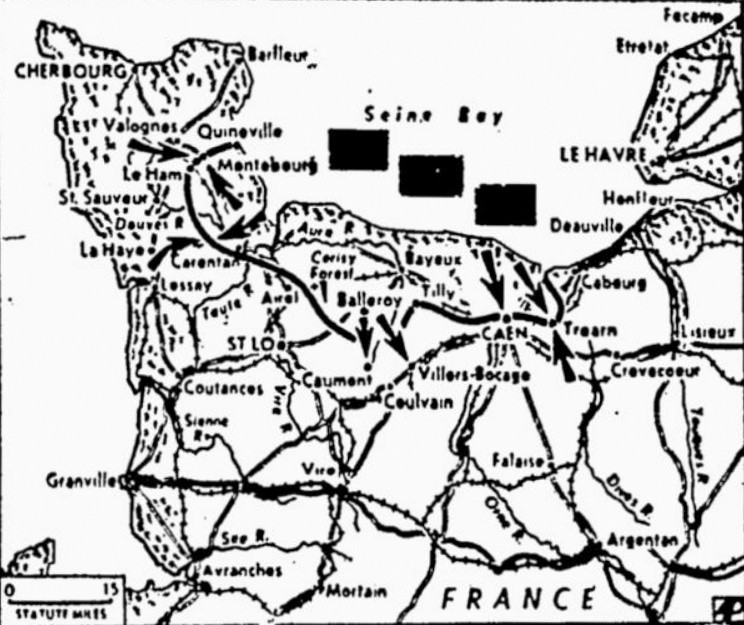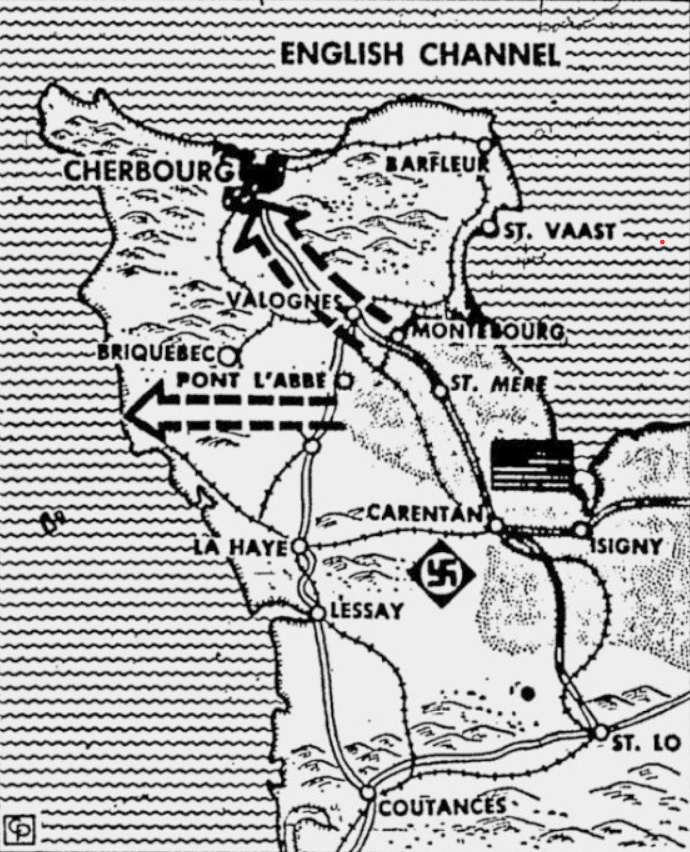Supreme HQ Allied Expeditionary Force (June 14, 1944)
Communiqué No. 17
West of TILLY-SUR-SEULLES, our armor found the enemy flank and struck south with great effect.
Advance patrols of our forces have now reached CAUMONT despite vigorous reaction on the part of the enemy.
In the sector between TILLY-SUR-SEULLES and CAEN, armored clashes continued to take place. There is strong pressure in the CARENTAN area.
Early yesterday evening, after a midday lull caused by bad weather, Allied aircraft resumed the offensive in one of the most concentrated efforts since the opening of the campaign. Enemy fighter opposition was sporadic but many of our aircraft encountered anti-aircraft fire.
Heavy day bombers with fighter escort attacked six bridges on the north-south railway system across the BREST PENINSULA and the airfields at BEAUVAIS/NIVILLERS and BEAUMONT-SUR-OISE.
Further to the southeast, two large formations of fighter-bombers attacked railway bridges over the LOIRE at LA POSSONNIÈRE and PORT-BOULET; another formation patrolled the ÉTAMPES-ORLÉANS railway seeking out traffic.
Throughout the CHERBOURG PENINSULA and in the immediate battle zone, large groups of fighter-bombers and rocket-firing aircraft attacked German troop concentrations, motor transport and other targets indicated by our ground forces.
Medium and light bombers in considerable strength bombed fuel dumps in the FORÊT D’ANDAINE and at DOMFRONT and SAINT-MARTIN, and the highway junctions at MARIGNY and CANISY. Beachhead patrols continued throughout the day and evening.
During the night, our fighters shot three enemy aircraft attacking the beachhead. Light bombers without loss attacked the railway yards at MÉZIDON.
Communiqué No. 18
The armored battle continued in the TILLY-CAEN area. The enemy has counterattacked constantly in a furious attempt to stem our advance. We are holding firm and vigorously searching out weak points in his attack.
In the CHERBOURG PENINSULA, the enemy is fighting fiercely. His heavy counterattacks in the north have forced us to give some ground in the vicinity of MONTEBOURG.
Further south we have made some gains. An enemy counterthrust on CARENTAN has been repulsed.
In one of their most active mornings, Allied air forces today operated almost unopposed from the BREST PENINSULA to BELGIUM and HOLLAND and penetrated deep into eastern France.
The effort of heavy day bombers exceeded even yesterday’s figures. Targets included airfields at LE BOURGET, CREIL, ORLÉANS-BRICY and ÉTAMPES-MONDESIR, in FRANCE, at BRUSSELS-MELSBROEK in BELGIUM, and EINDHOVEN in HOLLAND.
After escorting the bombers, our fighters hit numerous road, rail and military targets in FRANCE. Two enemy aircraft were destroyed. Fifteen bombers and eight fighters are missing from these widespread operations.
Before dawn, medium and light bombers hit communications targets near CAEN, in close support of our ground forces. Attacks were made on a marshalling yard at MÉZIDON and against bridges and traffic centers at AUNAY-SUR-ODON, FALAISE, VIRE, VIMOUTIERS, and FLERS. Other formations struck far into the interior, bombing traffic points and moving targets in the CHARTRES region, southwest of PARIS, rail tracks west of LAVAL and railway guns south of the battle area.
No enemy fighters were encountered in these operations, but anti-aircraft fire was heavy. One medium bomber is missing.
Fighters, fighter bombers, and rocket-firing fighters, some of them operating from bases in NORMANDY, gave close support to troops in the CHERBOURG PENINSULA, cutting railroads and attacking large enemy convoys. Other fighters scored rocket hits on barges and batteries. Coastal aircraft harassed E-boats near LE TOUQUET.
Shortly after midnight, seven enemy M-Class minesweepers were intercepted west of the MINQUIERS ROCKS by ORP PIORUN and HMS ASHANTI (Cdr. J. R. Barnes, RN) while on patrol. Action was joined at about 3,000 yards, the enemy being illuminated with star shells. The enemy vessels were repeatedly hit and scattering, some of them sought shelter under the guns of the coastal batteries on the island of JERSEY.
Of the seven enemy vessels engaged, three were observed to sink and one was seen to receive such damage that its survival is considered unlikely. Of the remaining three, two were left stopped and burning fiercely.
Northeast of CAP DE LA HAGUE, three enemy patrol vessels were intercepted and attacked early this morning by light coastal forces commanded by Lt. H. ASCOLI, RNVR, the first ship in the enemy line was hit with a torpedo and the second set on fire.

